Mastering wedding invitation etiquette doesn't have to break the bank. You'll need to include essential elements like host names, clear invitation wording, and event details. Choose between formal and informal addressing styles, and adapt your wording for different family situations. Consider budget-friendly alternatives like DIY invitations, digital options, or postcard designs. Time your mailings carefully, typically 6-8 weeks before the wedding, and manage RSVPs efficiently. Don't forget to weigh your invitations for correct postage. By balancing tradition with modern options, you can create invitations that impress your guests while keeping costs in check. Dive deeper to uncover more insider tips for invitation success.
Key Takeaways
- Choose formal or informal addressing styles based on your wedding tone, using appropriate titles and names.
- Utilize budget-friendly alternatives like DIY invitations, digital platforms, or postcard designs to reduce costs.
- Mail invitations 6-8 weeks before the wedding date, allowing guests ample time to prepare.
- Include essential elements like host names, invitation line, couple's names, date, time, and venue details.
- Manage RSVPs efficiently with clear deadlines and convenient response options for guests.
Essential Elements of Wedding Invitations
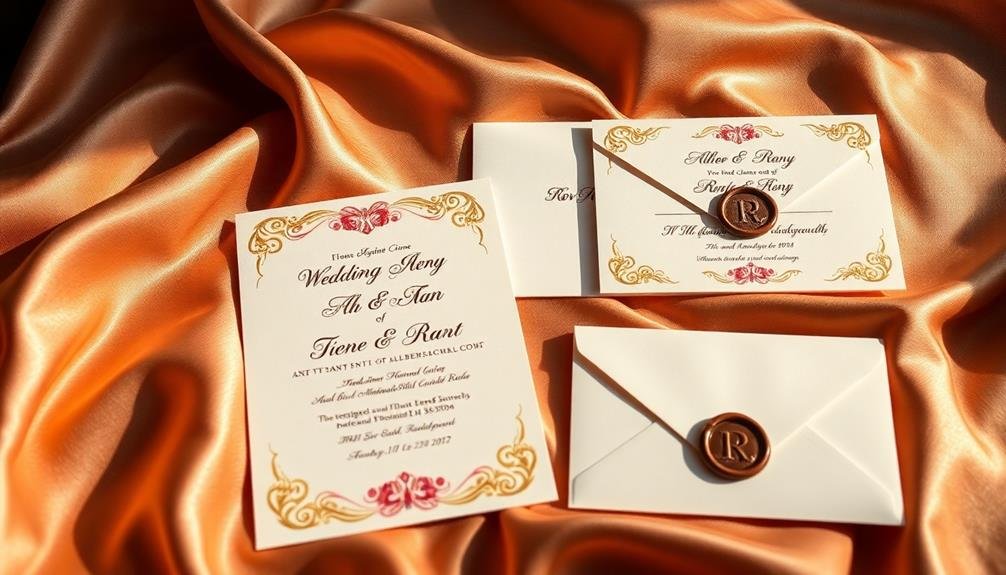
A well-crafted wedding invitation sets the tone for your special day and provides essential information to your guests. When designing your invitations, include these key elements to guarantee you're covering all the bases.
First, prominently display the names of the hosts, typically the couple or their parents. Follow this with a clear invitation line, such as "request the pleasure of your company." Next, include the names of the bride and groom, or the couple being wed.
Don't forget to specify the date, time, and full address of both the ceremony and reception venues. If they're at the same location, make this clear. Include any dress code information, especially if it's not standard formal wear.
Provide RSVP instructions, including a deadline and preferred method of response. If you're having an adults-only celebration, tactfully indicate this on the invitation.
For destination weddings, include travel and accommodation details or direct guests to a wedding website for more information.
Lastly, consider adding personal touches that reflect your style as a couple, such as a meaningful quote or custom artwork. These elements will make your invitation unique and memorable.
Proper Addressing Techniques
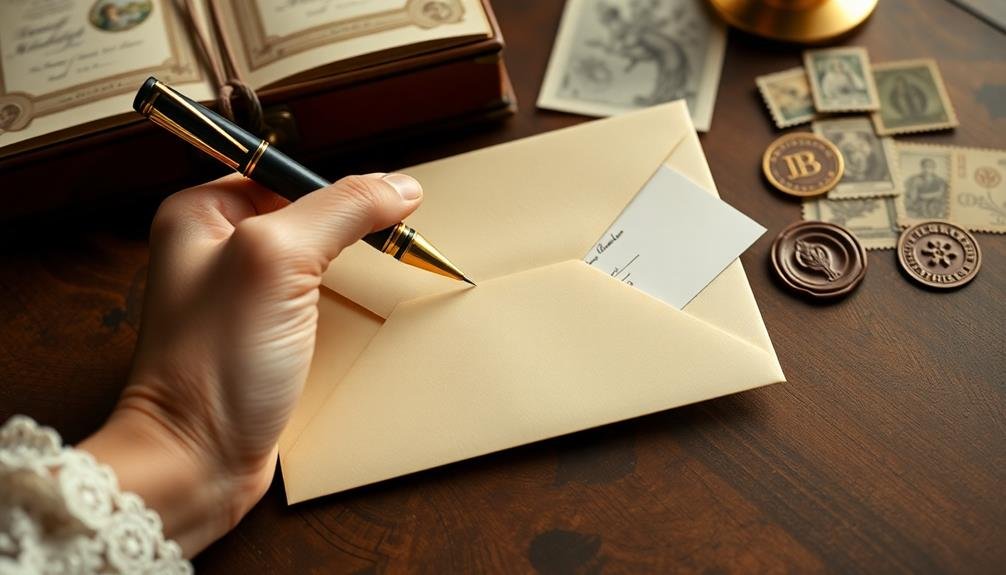
When addressing your wedding invitations, you'll need to contemplate whether to use formal or informal styles.
Your choice will impact how you write names, titles, and addresses on the envelopes.
Remember to pay special attention to guests with professional titles or military ranks, as these require specific formatting.
Formal vs. Informal Addressing
Steering through the world of wedding invitation addressing can be tricky.
You'll need to decide between formal and informal styles, depending on your wedding's tone and your relationship with the guests.
Formal addressing is traditional and best suited for classic, elegant weddings. Use titles like "Mr.," "Mrs.," "Dr.," or "The Honorable," followed by full names. For married couples, write "Mr. and Mrs. John Smith." For unmarried couples living together, list them on separate lines. Always spell out words like "Street" and "Avenue."
Informal addressing is more relaxed and fitting for casual or modern weddings. You can use first names only, omit titles, or include nicknames. For couples, you might write "Jane and John Smith" or "The Smith Family." It's okay to use abbreviations for street names and states.
Special Title Considerations
Several special titles require careful consideration when addressing wedding invitations. When inviting medical doctors, use "Doctor" before their name, such as "Doctor Jane Smith" or "Dr. and Mrs. John Doe" if only one spouse is a doctor.
For military personnel, include their rank before their name, like "Lieutenant Colonel James Brown." If both spouses are in the military, list the higher-ranking person first.
For clergy members, use appropriate titles such as "The Reverend John Smith" or "Rabbi Sarah Cohen." When addressing judges, use "The Honorable" before their name.
For elected officials, research their correct title and use it accordingly, such as "Mayor Jane Johnson" or "Senator Mark Williams."
If you're unsure about someone's title or prefer a more casual approach, it's acceptable to use "Mr.," "Mrs.," "Ms.," or "Mx." followed by their full name.
Remember that some individuals may have professional titles but prefer to be addressed informally for social occasions. When in doubt, it's always best to ask the person directly how they'd like to be addressed on your wedding invitation.
Wording Etiquette for Different Scenarios
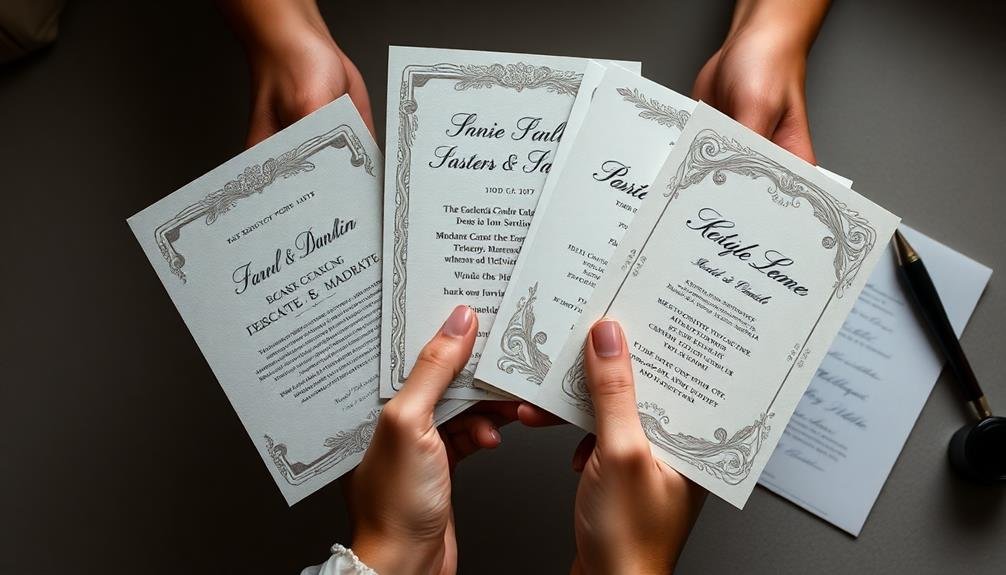
Crafting the perfect wedding invitation wording can be tricky, especially when faced with unique family situations or non-traditional ceremony formats.
Here's how to navigate common scenarios:
For divorced parents, list them separately on different lines. If one has remarried, include the step-parent's name. When parents are hosting together despite divorce, use "Mr. John Smith and Ms. Jane Doe request the honor of your presence…"
For same-sex couples, use "Mr. and Mr." or "Ms. and Ms." followed by their names. Alternatively, simply state both full names without titles.
If you're paying for the wedding yourselves, use "Together with their families" or "Jane Smith and John Doe request the pleasure of your company…"
For blended families, consider using "… and families invite you to celebrate the wedding of…"
For casual ceremonies, feel free to use less formal language like "Join us for the wedding of…" or "We're tying the knot!"
Remember to include essential details like date, time, and venue.
Always proofread carefully to avoid embarrassing mistakes.
With these guidelines, you'll create invitations that reflect your unique circumstances while maintaining proper etiquette.
Budget-Friendly Invitation Alternatives
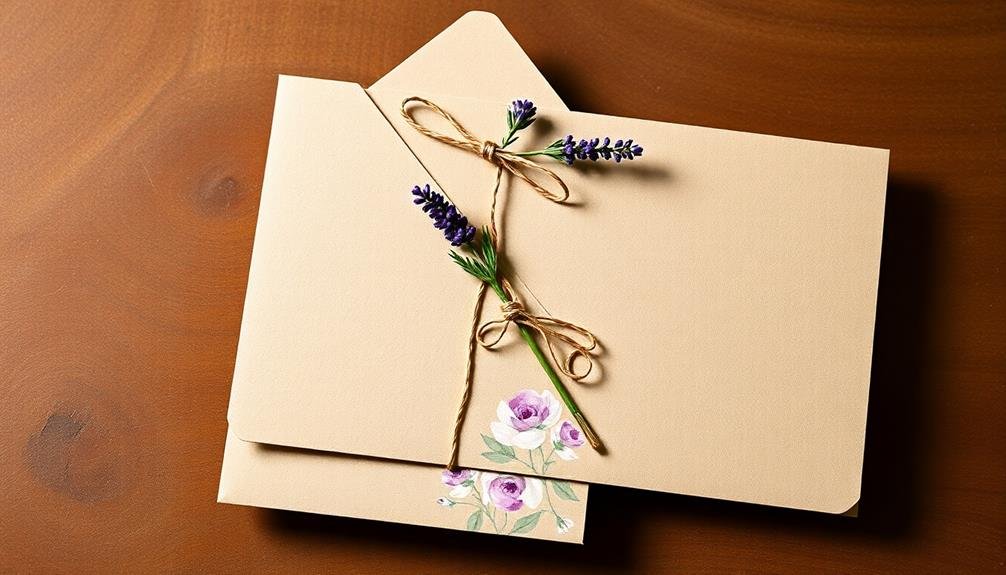
For couples on a tight budget, there are plenty of creative alternatives to expensive traditional invitations. You can opt for DIY invitations, which allow you to personalize your design while keeping costs low. Use online templates or graphic design software to create unique layouts, then print them at home or at a local print shop.
Digital invitations are another cost-effective option. Websites like Paperless Post or Greenvelope offer elegant e-invites that you can customize and send electronically. This approach not only saves money but also reduces paper waste.
Consider postcard invitations, which require less postage and materials than traditional card-and-envelope sets. They're compact, eye-catching, and can still convey all the necessary information.
If you're crafty, try hand-lettering your invitations or using calligraphy stamps. This personal touch adds charm without breaking the bank.
Alternatively, explore printing methods like letterpress or foil stamping on a single-card design to achieve a luxurious look at a lower cost.
Don't forget to leverage your social media presence. Create a wedding website and share the link with guests, providing all the details they need while minimizing printing and postage expenses.
Timing and Mailing Considerations
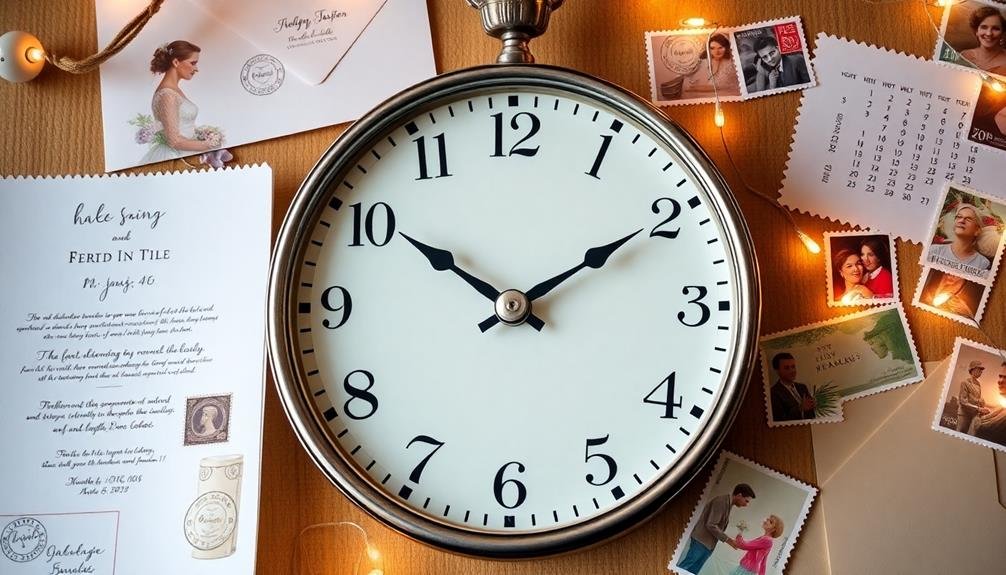
When it comes to wedding invitations, timing is essential.
You'll want to take into account the ideal mailing timeline, which typically ranges from 6 to 8 weeks before the wedding date.
Don't forget to research postage and delivery options, as these can impact both your budget and the arrival of your invitations.
Ideal Mailing Timeline
To guarantee your guests have ample time to prepare, mailing wedding invitations at the right moment is essential. Generally, you should send out invitations six to eight weeks before your wedding date. This timeframe allows guests to arrange travel, request time off work, and make other necessary preparations.
For destination weddings or events during peak travel seasons, consider mailing invitations 10 to 12 weeks in advance. This extra time is important for guests who need to book flights and accommodations.
If you've sent save-the-dates, you can stick to the six to eight-week timeline, as your guests will already be aware of the date.
Don't forget to set your RSVP deadline for three to four weeks before the wedding. This gives you time to follow up with non-respondents and finalize your guest count for vendors.
If you're planning a more casual affair or have mostly local guests, you can send invitations four to six weeks before the event. However, err on the side of caution and give your guests more time rather than less.
Postage and Delivery Options
Choosing the right postage and delivery options for your wedding invitations is crucial for guaranteeing they reach your guests on time and in perfect condition. First, weigh a complete invitation set at your local post office to determine the correct postage. Remember that square or oddly-shaped envelopes may require additional postage. Think about purchasing commemorative stamps to add a personal touch.
For standard delivery, first-class mail is usually sufficient and cost-effective. However, if you're sending invitations internationally or to remote areas, priority mail might be a better option. Track your invitations by using certified mail or adding tracking services, especially for VIP guests or those traveling from afar.
Hand-canceling is another option to think about. This process involves manually stamping each envelope, which can help prevent damage from automated sorting machines. While some post offices offer this service for free, others may charge a small fee.
If you're short on time or want to guarantee maximum precision, think about using a professional mailing service. They can handle addressing, stuffing, and mailing your invitations, saving you time and stress during the busy wedding planning period.
Digital Invitations: Pros and Cons
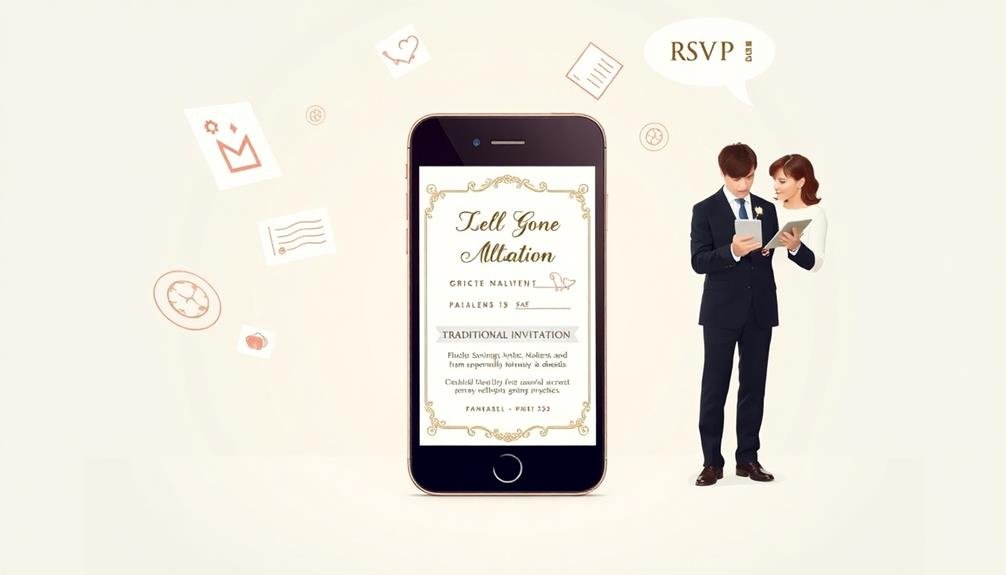
With the rise of technology, digital wedding invitations have become an increasingly popular option for couples. They offer several advantages, including cost-effectiveness, ease of distribution, and the ability to track RSVPs in real-time.
You'll save on printing and postage costs, and you can easily update information or send reminders to guests. Digital invitations also allow for more creativity, with options for animated designs and interactive elements.
However, there are drawbacks to take into account. Some guests, particularly older relatives, may not be comfortable with digital formats or may lack reliable internet access.
Digital invitations can also feel less personal or formal than traditional paper invitations, which some couples and guests prefer for such a significant occasion. There's also the risk of invitations getting lost in spam folders or overlooked in busy email inboxes.
If you're pondering digital invitations, weigh these pros and cons carefully. You might choose a hybrid approach, sending digital invitations to most guests while mailing physical copies to those who prefer them.
Whatever you decide, make certain your invitations reflect your wedding's tone and style while effectively communicating essential information to your guests.
Handling RSVPs Gracefully
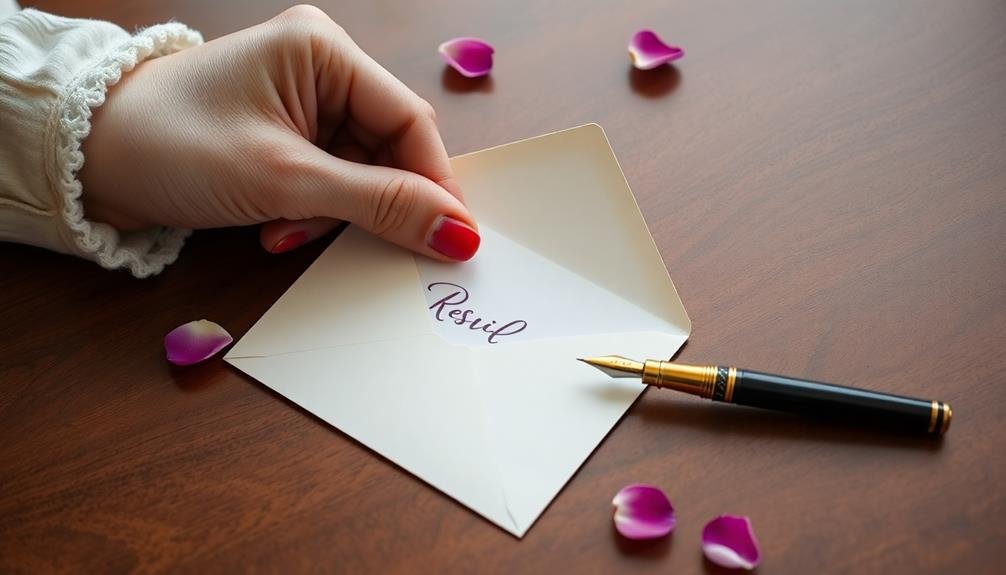
Receiving and managing RSVPs is a key part of the wedding planning process. To handle them gracefully, start by setting a clear RSVP deadline on your invitation, typically 3-4 weeks before the wedding.
Make it easy for guests to respond by including pre-stamped RSVP cards or providing a simple online option.
As responses come in, keep track of them in a spreadsheet or wedding planning app. This will help you manage guest counts, meal choices, and seating arrangements.
Don't forget to note any dietary restrictions or special requests.
For guests who haven't responded by the deadline, it's okay to follow up. Send a polite text, email, or make a quick phone call to confirm their attendance.
Remember, some people may have simply forgotten or lost the invitation.
Be prepared for last-minute changes. Some guests may cancel at the eleventh hour, while others might ask to bring a plus-one.
Handle these situations with grace and flexibility, but don't feel obligated to accommodate every request if it doesn't align with your plans or budget.
Frequently Asked Questions
How Do I Handle Invitations for Guests With Food Allergies or Dietary Restrictions?
You should include a space for dietary restrictions on your RSVP cards. Ask guests to specify any allergies or special diets. Once you've collected this information, work with your caterer to accommodate these needs for your wedding menu.
Should We Include Registry Information on the Wedding Invitation?
You shouldn't include registry information on your wedding invitation. It's considered impolite. Instead, spread registry details through word of mouth or on your wedding website. If guests ask, you can provide the information directly.
Is It Necessary to Send Invitations to Guests Who've Already Confirmed Attendance?
Yes, you should still send invitations to guests who've already confirmed. It's a formal way to provide essential details, and they'll appreciate the keepsake. Plus, it guarantees everyone has the same information about your big day.
How Do We Politely Inform Guests That Children Are Not Invited?
You can politely exclude children by addressing invitations to specific adults only. On your wedding website or through word-of-mouth, you may clarify it's an adults-only event. Be prepared to handle questions gracefully if they arise.
What's the Etiquette for Inviting Coworkers to a Wedding?
When inviting coworkers, you'll want to be consistent. Either invite all or none from your department. If you're close to specific colleagues, consider inviting them as friends rather than coworkers. Be discreet to avoid workplace tension.
In Summary
You've now got the tools to navigate wedding invitation etiquette without breaking the bank. Remember, it's about striking a balance between tradition and your personal style. Whether you opt for classic paper invites or modern digital alternatives, guarantee your invitations reflect your love story. Don't stress over every detail; focus on clearly communicating essential information to your guests. With these tips in hand, you're ready to set the tone for your special day with confidence and grace.

I’m Sarah, the creator and writer behind this site. I’m a wife and a mother of two wonderful kids who keep me on my toes and inspire me daily. My passion lies in creating and organizing memorable events and group activities, where people can come together and make lasting memories.

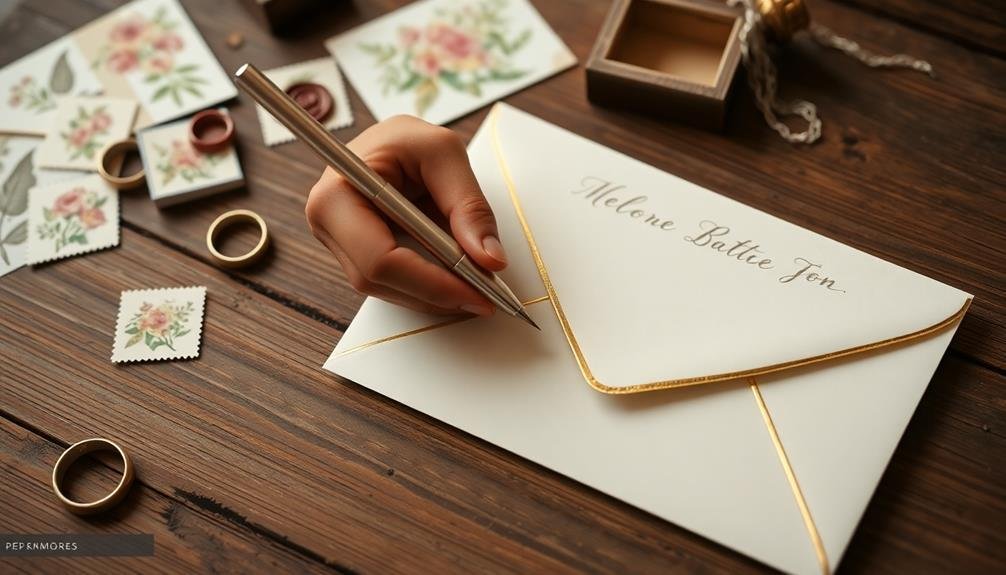



Leave a Reply